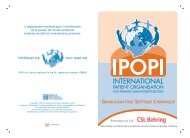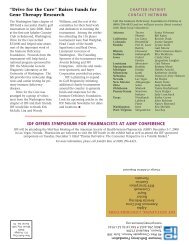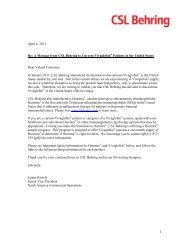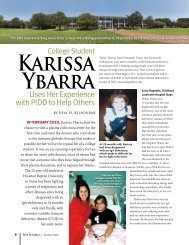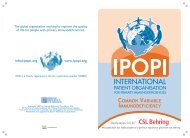IDF Patient & Family Handbook for Primary Immunodeficiency ... - IDFA
IDF Patient & Family Handbook for Primary Immunodeficiency ... - IDFA
IDF Patient & Family Handbook for Primary Immunodeficiency ... - IDFA
Create successful ePaper yourself
Turn your PDF publications into a flip-book with our unique Google optimized e-Paper software.
Inheritance<br />
75<br />
Types of Inheritance continued<br />
The chances <strong>for</strong> a given egg combining with a<br />
given sperm are completely random. According<br />
to the laws of probability, the chance <strong>for</strong> any given<br />
pregnancy of a carrier female to result in each of<br />
these outcomes is as follows:<br />
Carrier female—1 in 4 chance or 25%<br />
Agammaglobulinemia male—1 in 4 chance or 25%<br />
Normal female—1 in 4 chance or 25%<br />
Normal male—1 in 4 chance or 25%<br />
It should be noted that the outcome of one<br />
pregnancy is not influenced by the outcome of a<br />
previous pregnancy. Just as in coin flipping, the fact<br />
that you get a “heads” on your first toss doesn’t<br />
mean you will get a “tails” on the next. Similarly, if<br />
you have a son with agammaglobulinemia with your<br />
first pregnancy you are not guaranteed to have an<br />
unaffected child with your second pregnancy; your<br />
chances of having a son with agammaglobulinemia<br />
are still 1 in 4 (25%) with each pregnancy.<br />
In most of the X-linked primary immunodeficiency<br />
diseases, carrier females can be identified by<br />
laboratory tests if the mutation in a given family<br />
has been determined. Consult with your physician<br />
or genetic counselor to learn if carrier detection is<br />
available in your specific situation.<br />
With earlier diagnosis and improved therapy,<br />
many young men with X-linked disorders, such<br />
as agammaglobulinemia, are reaching adult<br />
life and having children of their own. Figure 3<br />
illustrates the kind of children that a man with<br />
X-linked agammaglobulinemia would have if he<br />
married a woman who did not carry the gene <strong>for</strong><br />
agammaglobulinemia. As can be seen in Figure 3, all<br />
of the daughters of an affected male would be carrier<br />
females and none of the sons would be affected.<br />
Autosomal Recessive<br />
Inheritance<br />
If a primary immunodeficiency disease can only<br />
occur if two abnormal genes (one from each parent)<br />
are present in the patient, then the disorder is<br />
inherited as an autosomal recessive disorder. If an<br />
individual inherits only one gene <strong>for</strong> the disorder;<br />
then he or she carries the gene <strong>for</strong> the disorder but<br />
does not have the disorder itself.<br />
CHAPTER 15; FIGURE 4<br />
Autosomal Recessive Inheritance—SCID Example








